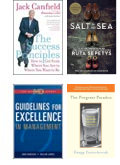Clearing one’s mind is both a cause and effect of greater control. If you are anxious, being disorganized serves to heighten the madness because it magnifies the havoc in a given situation. Your thought process and your physical surroundings thus mirror one another. The paradoxical pairing down of our possessions and our resultant happiness is not therefore an accident, but rather a byproduct of removing what is burdensome.
Organization is a self-reinforcing cycle that promotes a feeling of centeredness, an inner serenity which induces a need for greater order, and peace from knowing that everything is in its proper place. Purge brings greater clarity, and a spacious mind creates room for new opportunities and a conduit to creative ideas.
Mess is a sign post of mental turbulence, and the converse of serenity reflected in an outer refuge. Hoarding is a manifestation of something that is occurring inside the mind – a form of self-sabotage and inaction that becomes self-fulfilling prophecy.
A clear path, whether though our myriad possessions or through our mind’s eye, may have more profound implications than we imagined. If there is chaos within, it may be impossible to reach for something higher, or (in the words of Maslow), to “self actualize.” What if our calling is masked by the debris of low self-esteem, lack of self-confidence, hatred (of self and others), along with a low grade fear of most things?
If I am apprehensive about my chances of success, I more than likely will not take the time to instigate an organizational scheme. If we knew disorganization was preventing the course of our unfolding, would we be more inclined to change?
If we are overwhelmed by the stench of our own mental excreta and frustrated by our own physical clutter, we are unable to perceive the daimon, or life blueprint which is our destiny. In The Soul’s Code, Hillman (1996) explains that “Catching the sly winks of fate is a reflective act (p. 194), which suggests that “fate,” or the process of your life’s evolution, finds you if you are in the right mindset. He argues: “These impulsions of destiny frequently are stifled by dysfunctional perceptions and unreceptive surroundings” (p. 13).
If our minds are filled with inner turmoil, we will be less likely to notice things around us, such as synchronicities, serendipitous occurrences, and small events that normally go unnoticed. Wiseman (2003) corroborates this viewpoint in his study of lucky people, whom he found (because of their relaxed, expectant, positive mindset) were able to capitalize on and create chance encounters.
It is design that helps you to connect with your inner self. Blanke (2009, p. 116) explains “When we throw out the physical clutter, we clear out our minds. When we throw out the mental clutter, we clear out our souls.” Imagine an entire lifestyle devoted to clearing out everything unwanted.
The spiritual side of design involves promoting harmony through the placement, selection, and retention of objects within your personal space. It is your job to salvage the treasures – those rich bits and functional behaviors from your past that will help propel you forward. From personal accounts, organization can even (in some cases) be an antidote for mental illness.[1]
The quest for order is then a path which leads to the unbundling of our non-essentials, and to the enhancement of our core competencies. It is not about just throwing away objects, but rather about eliminating the unwanted (both within and without) and enjoying the synergy of both processes working on our behalf.
May order reign within your inner world and manifest within your presence.
___________________________________________________________________________________________________________
References
Blanke, G. (2010). Throw out fifty things: Clear the clutter, find your life. New York: Hachette Book Group.
Hillman, J. (1996). The soul’s code: in search of character and calling. New York: Warner Books.
Morgenstern, J. (2009). Shed your stuff, change your life: A four step guide to getting unstuck. New York: Simon & Schuster.
[1] Morgenstern (2009) describes a depressed client who found that de-cluttering was successful in destabilizing his ingrained, negative thought patterns.





Recent Comments